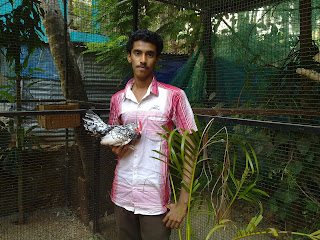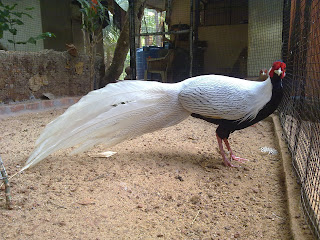Friday, 27 January 2012
Tuesday, 24 January 2012
Lady Amherst Pheasant
Lady Amherst Pheasant
The Lady Amherst's Pheasant, Chrysolophus amherstiae, is a bird of the order Galifornium and the family Phasianidae.
These are native to south western China and Myanmar, but have been introduced elsewhere, and have established a self-supporting, but now declining, feral population in England, the stronghold of which is now in Bedfordshire.
The adult male is 100-120 cm in length, its tail accounting for 80 cm of the total length. It is unmistakable with its black and silver head, long grey tail and rump, and red, blue, white and yellow body plumage. The "cape" can be raised in display.
This species is closely related to the Golden Pheasant and the introduced populations in England will interbreed.
The female is much less showy, with a duller mottled brown plumage all over, similar to that of the female Common Pheasant but with finer barring. She is very like the female Golden Pheasant, but has a darker head and cleaner underparts than the hen of that species.
Despite the male's showy appearance, these birds are very difficult to see in their natural habitat, which is dense, dark forests with thick undergrowth. Consequently, little is known of their behaviour in the wild.
They feed on the ground on grain, leaves and invertebrates, but roost in trees at night. Whilst they can fly, they prefer to run, but if startled they can suddenly burst upwards at great speed, with a distinctive wing sound.
The male has a gruff call in the breeding season.
The name commemorates Sarah Countess Amherst, wife of William Pitt Amherst, Governor General of Bengal, who was responsible for sending the first specimen of the bird to London in 1828.
Widespread throughout its large range, the Lady Amherst's Pheasant is evaluated as Least Concern on the IUCN Red List of Threatened Species.
Ring necked Pheasant
Ring Necked Pheasant
The Ring necked Pheasant (Phasianus colchicus), is a bird in the pheasant family (Phasianidae). It is native to Georgia (AncientColchis) and has been widely introduced elsewhere as a game bird. In parts of its range, namely in places where none of its relatives occur such as in Europe (where it is naturalized), it is simply known as the "pheasant". Ring-necked Pheasant is both the name used for the species as a whole in North America and also the collective name for a number of subspecies and their intergrades which have white neck rings.
The word pheasant is derived from the ancient town of Phasis, the predecessor of modern Poti in Western Georgia). See below for details.
It is a well-known gamebird, among those of more than regional importance perhaps the most widespread and ancient one in the whole world. The Common Pheasant is one of the world's most hunted birds; it has been introduced for that purpose to many regions, and is also common on game farms where it is commercially bred. Ring-necked Pheasants in particular are commonly bred and were introduced to many parts of the world; the game farm stock, though no distinct breeds have been developed yet, can be considered semi-domesticated. The Ring-necked Pheasant is the state bird of South Dakota, one of only three US state birds that is not a species native to the United States.
Description
 |
Phasianus colchicus call
|
There are many colour forms of the male Common Pheasant, ranging in colour from nearly white to almost black in some melanistic examples. These are due to captive breeding and hybridization between subspecies and with the Green Pheasant, reinforced by continual releases of stock from varying sources to the wild. For example, the "Ring-necked Pheasants" common in Europe, North America and Australia do not pertain to any specific taxon, they rather represent a stereotyped hybrid swarm. Body weight can range from 0.5 to 3 kg (1.1-6.6 lb), with males averaging 1.2 kg (2.6 lb) and females averaging 0.9 kg (2 lb).
The adult male Common Pheasant of the nominate subspecies Phasianus colchicus colchicus is 60–89 cm (24–35 in) in length with a long brown streaked black tail, accounting for almost 50 cm (20 in) of the total length. The body plumage is barred bright gold and brown plumage with green, purple and white markings. The head is bottle green with a small crest and distinctive red wattle. P. c. colchicus and some other races lack a white neck ring.

Monday, 23 January 2012
Goose
Goose (Geese)
Geese are waterfowl belonging to the tribe Anserini of the family Anatidae. This tribe comprises the genera Anser (the grey geese),Branta (the black geese) and Chen (the white geese). A number of other birds, mostly related to the shelducks, have "goose" as part of their name. More distantly related members of the Anatidae family are swans, most of which are larger than true geese, and ducks, which are smaller.
Mandarin Duck
Mandarin Duck
The Mandarin Duck (Aix galericulata), or just Mandarin, is a medium-sized perching duck, closely related to the North American Wood Duck. It is 41–49 cm long with a 65–75 cm wingspan.
Description
The adult male is a striking and unmistakable bird. It has a red bill, large white crescent above the eye and reddish face and "whiskers". The breast is purple with two vertical white bars, and the flanks ruddy, with two orange "sails" at the back. The female is similar to female Wood Duck, with a white eye-ring and stripe running back from the eye, but is paler below, has a small white flank stripe, and a pale tip to its bill. The Mandarin ducklings are almost identical in look to Wood ducklings, and appear very similar to Mallard ducklings. The ducklings can be distinguished from Mallard ducklings because the eye-stripe of Mandarin ducklings (and Wood ducklings) stops at the eye, while in Mallard ducklings it reaches all the way to the bill.
Silver Pheasant
Silver Pheasant
The Silver Pheasant (Lophura nycthemera) is a species of pheasant found in forests, mainly in mountains, of mainland Southeast Asia, and eastern and southern China, with introduced populations in Hawaii and various locations in the US mainland. The male is black and white, while the female is mainly brown. Both sexes have a bare red face and red legs (the latter separating it from the greyish-leggedKalij Pheasant).It is common in aviculture, and overall also remains common in the wild, but some of its subspecies (notablywhiteheadi from Hainan, engelbachi from southern Laos, and annamensis from southern Vietnam) are rare and threatened.
Description
Males of the northern subspecies, which are the largest, have white upper parts and tail (most feathers with some black markings), while their underparts and crest are glossy bluish-black. The males of the southern subspecies have greyer upperparts and tail with extensive black markings, making them appear far darker than the northern subspecies. The adult male plumage is reached in the second year.This is a relatively large pheasant, with males of the largest subspecies having a total length of 120 to 125 cm (47 to 49 in), including a tail of up to 75 cm (30 in), while the males of the smallest subspecies barely reach 70 cm (28 in) in total length, including a tail of about 30 cm (12 in). The body mass of males can range from 1.13–2 kg (2.5–4.4 lb). Females of all subspecies are notably smaller than their respective males, with a size range of 55–90 cm (22–35 in) in total length, including a tail of 24–32 cm (9.4–13 in). The body mass of females can range from 1–1.3 kg (2.2–2.9 lb).
Females are brown and shorter-tailed than the males. Females of some subspecies have whitish underparts strongly patterned with black, and in whiteheadi this extends to the upper mantle.
Subscribe to:
Comments (Atom)


















































